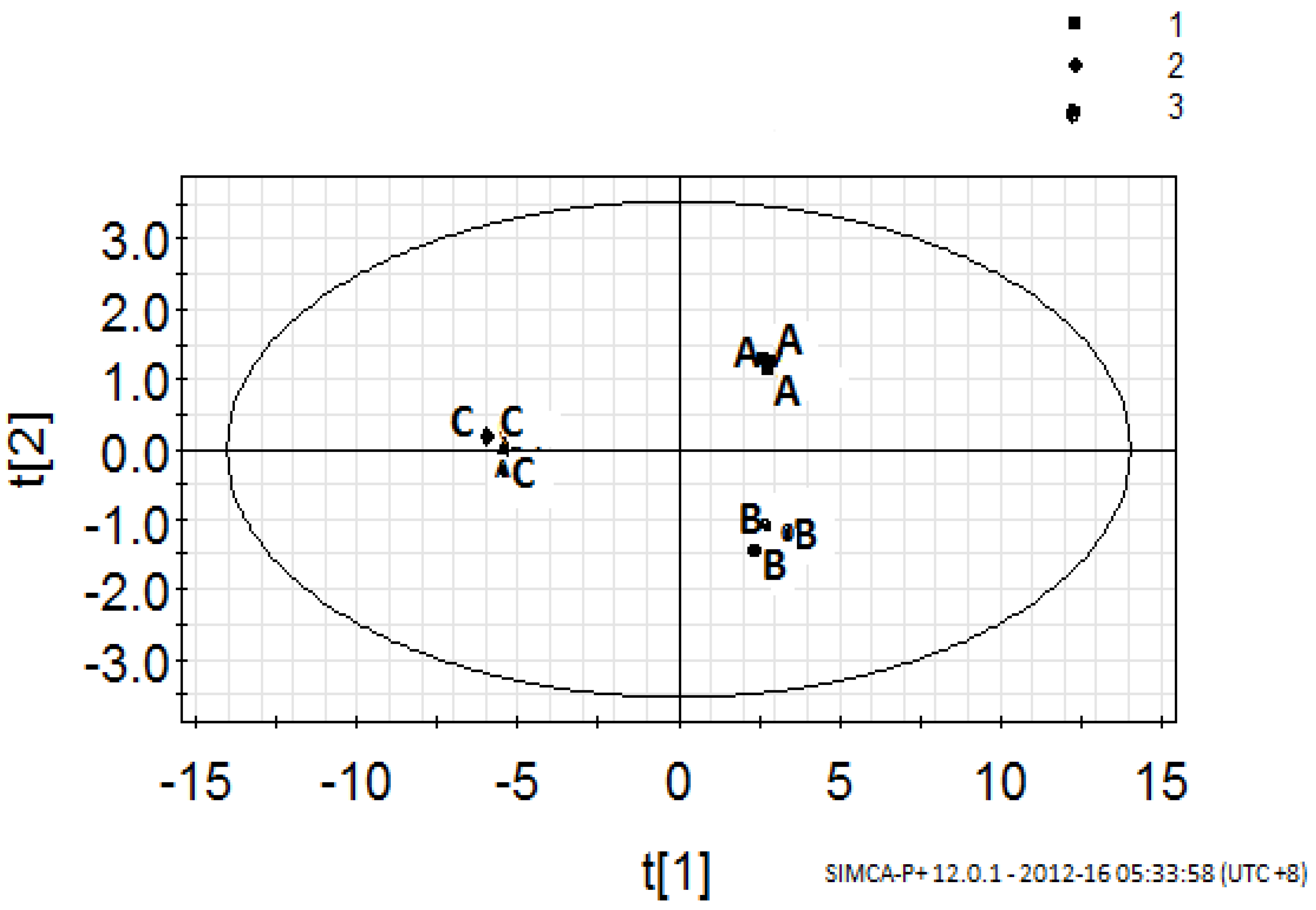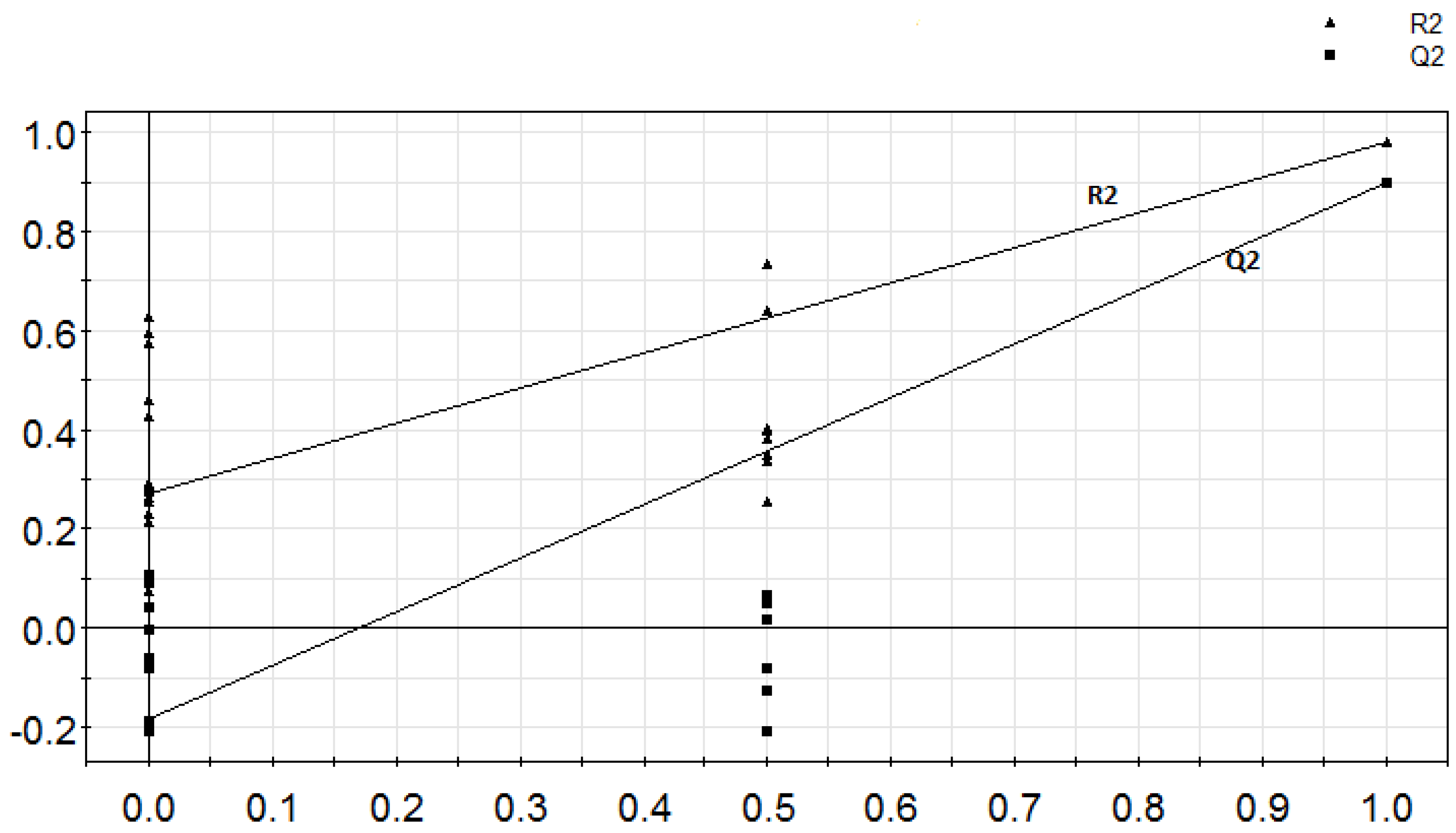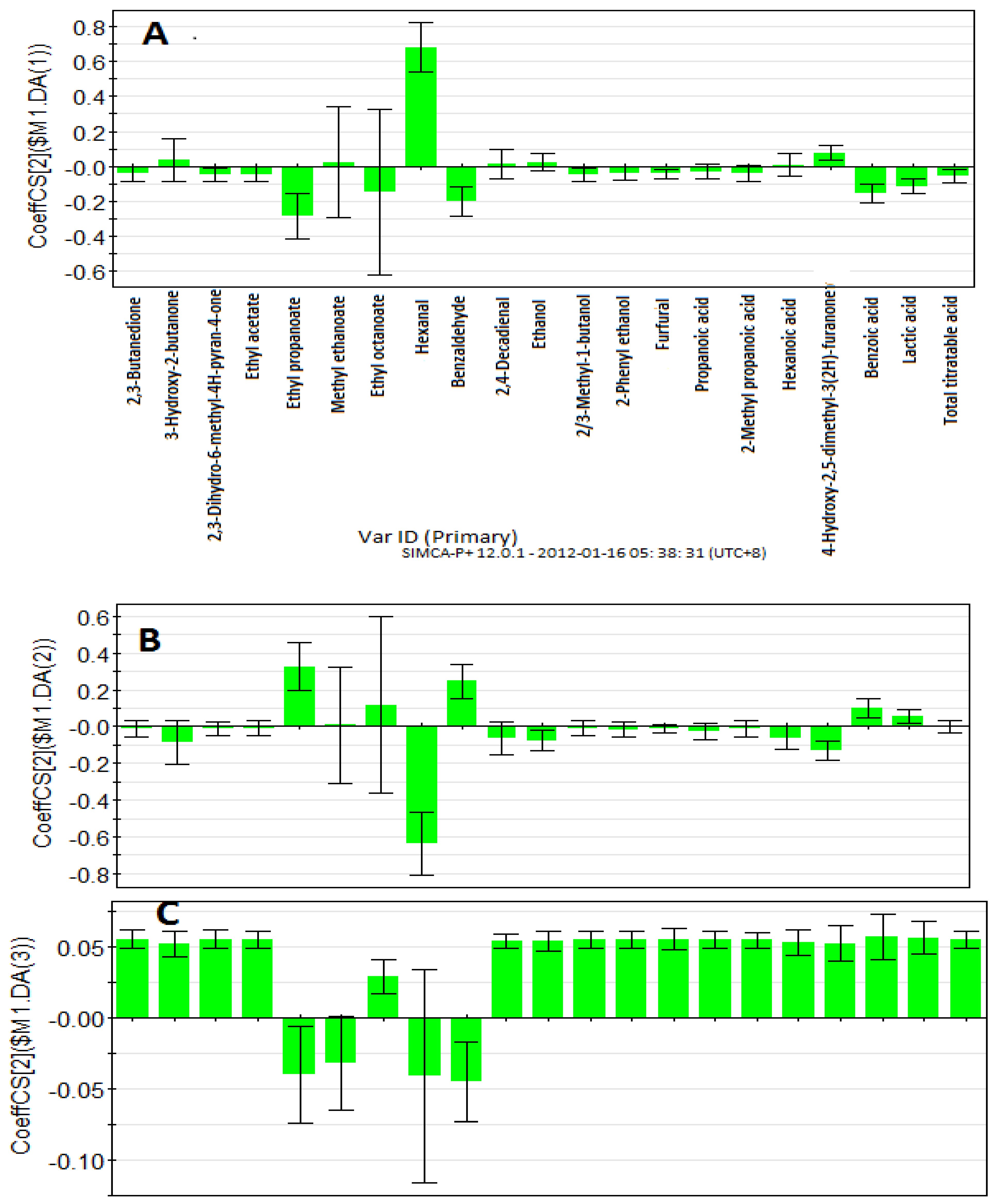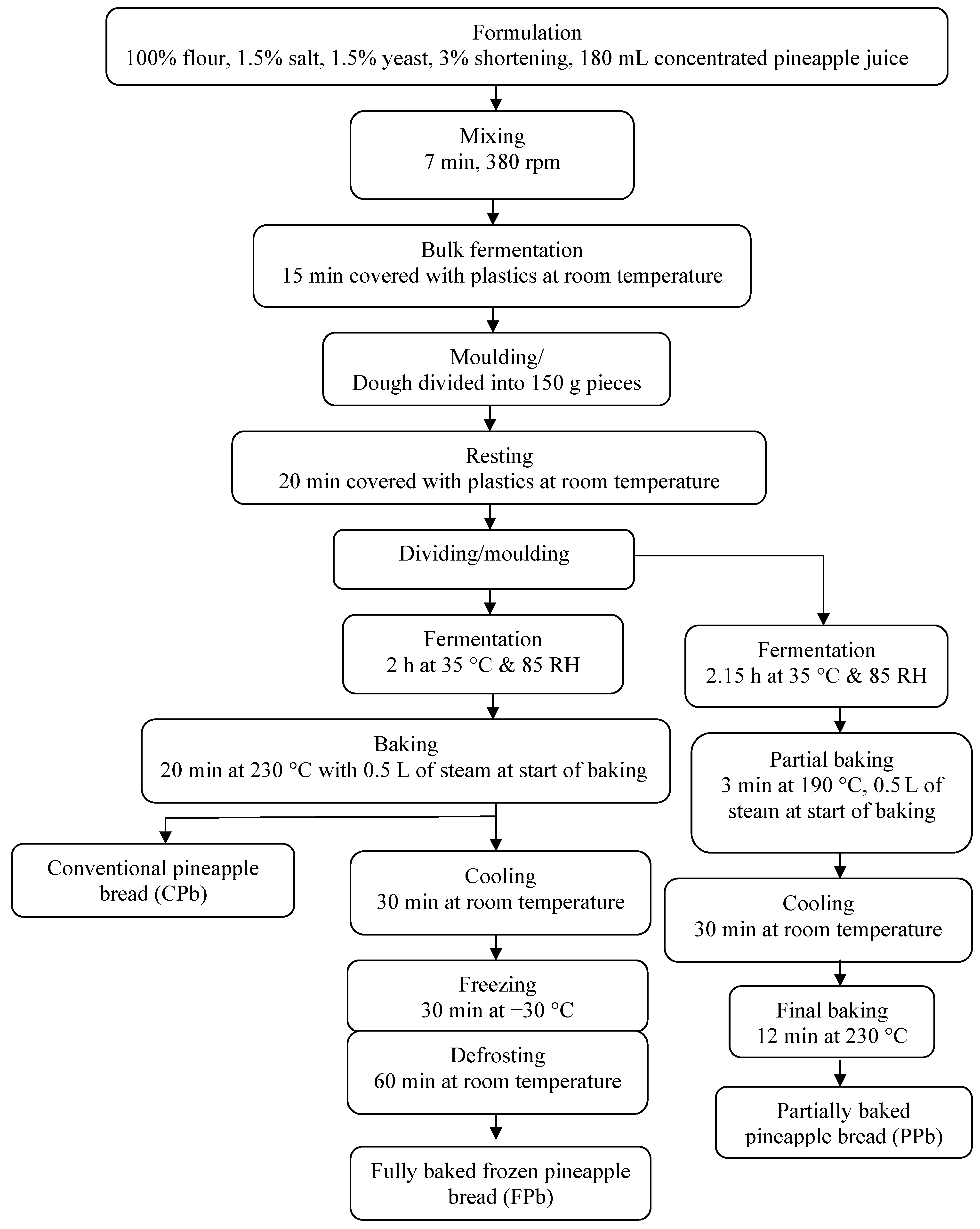Headspace Solid-Phase Microextraction Gas Chromatography-Mass Spectrometry and Gas Chromatography-Olfactometry Analysis of Volatile Compounds in Pineapple Breads
Abstract
:1. Introduction
2. Results and Discussion
2.1. Calibration, Linearity and Recovery
| Compounds No. | Linear range (µg.g−1) | Limit of detection (LOD, µg.g−1) | Recovery (%) |
|---|---|---|---|
| 1. Acetic acid | 10–200 | 5.92 | 97.4 |
| 2. Propanoic acid | 5–250 | 1.27 | 98.1 |
| 3. Hexanoic acid | 20–250 | 9.81 | 90.4 |
| 4. Benzoic acid | 10–250 | 8.65 | 89.4 |
| 5. Ethanol | 10–200 | 5.82 | 87.8 |
| 6. 2/3-Methyl-1-butanol | 10–150 | 7.14 | 98.5 |
| 7. 2-Phenylethanol | 10–200 | 4.53 | 94.8 |
| 8. Hexanal | 10–200 | 7.34 | 90.1 |
| 9. Benzaldehyde | 10–250 | 6.33 | 95.3 |
| 10. (E,E)-2,4-decadienal | 10–150 | 5.98 | 91.4 |
| 11. 2,3-Butanedione | 10–250 | 6.72 | 97.4 |
| 12. 3-Hydroxy-2-butanone | 10–250 | 6.32 | 96.2 |
| 13. Ethyl acetate | 10–200 | 7.4 | 99.1 |
| 14. Ethyl propanoate | 10–200 | 9.13 | 92.7 |
| 15. Methyl ethanoate | 10–250 | 4.37 | 96.3 |
| 16. Ethyl octanoate | 10–200 | 7.09 | 90.4 |
| 17. Furfural | 10–200 | 5.97 | 90.6 |
| 18. Furfury alcohol | 10–250 | 6.54 | 94.4 |
| 19. 2-Methylpropanoic acid | 10–200 | 8.35 | 90.8 |
| 20. 2,3-Dihydroxy-6-methyl-4H-pyran-4 one | 10–250 | 7.66 | 91.3 |
| 21. 4-Hydroxy-2,5-dimethyl-3(2H)-furanone | 10–200 | 5.78 | 96.7 |
2.2. Sensory Evaluation of Breads
| Attributes | Bread type * | ||
|---|---|---|---|
| CPb | FPb | PPb | |
| Aroma | 7.1 ± 0.1 ab | 7.6 ± 0.1 a | 8.0 ± 0.2 a |
| Taste | 7.4 ± 0.2 a | 8.0 ± 0.1 a | 8.4 ± 0.1 a |
| Overall quality | 7.0 ± 0.1 b | 8.3 ± 0.1 a | 8.7 ± 0.1 a |
2.3. Identification of Volatile Compounds
| Number | Odourant a | Odour quality b | FD | Retention index DB-5 | Previously identified in bread c |
|---|---|---|---|---|---|
| 1 | Ethyl acetate | Pineapple-like | 32 | 628 | 2, 4 |
| 2 | Propanoic acid | Rancid | 32 | 668 | 4, 7 |
| 3 | Methyl-2-methylpropionate | Fruity, sweet | 4 | 687 | 9 |
| 4 | 2,3-Pentanedione | Buttery | 16 | 710 | 1, 4, 5 & 10 |
| 5 | Ethyl propionate | Fruity | 64 | 713 | |
| 6 | Butanoic acid | sour | 2 | 718 | 4, 5 |
| 7 | 3-Hydroxy-2-butanone | Buttery | 64 | 720 | 2, 3 |
| 8 | Ethyl-2-methyl propionate | Sweet-fruity | 4 | 754 | 4, 6, 9 |
| 9 | 2-/3Methyl-1-butanol | Malty | 128 | 769 | 2, 3, 4 |
| 10 | 1-Hexen-3-one | Green | 2 | 774 | 1, 4, 10 |
| 11 | Hexanal | Green, tallow | 32 | 787 | 1,2, 3, 7 |
| 12 | 2,3-Butanediol | Fruity, onion | 8 | 802 | 1, 2 |
| 13 | Furfural | Bread-like | 64 | 826 | 1, 2, 3 |
| 14 | 2-Methyl butanoic acid | Sweaty | 16 | 831 | 1, 4 |
| 15 | Ethyl-2-methyl butanoate | Fruity | 8 | 838 | 9 |
| 16 | Furfuryl alcohol | Burnt | 16 | 863 | |
| 17 | Methyl ethanoate | Fruity | 32 | 864 | 4 |
| 18 | (Z)-4-Heptenal | Biscuit-like, sweet | 16 | 894 | 1, 4, 5, 6, 7, 10 |
| 19 | Methional | cooked-potato | 4 | 919 | 4, 5, 6, 7, 10 |
| 20 | 2-Acetyl-1-pyrroline d | Popcorn-like | 16 | 922 | 4, 5, 6, 10 |
| 21 | Benzaldehyde | Almond-like | 64 | 936 | 4,7 |
| 22 | Ethanol | Alcoholic | 32 | 945 | 3, 6, |
| 23 | Hexanoic acid | Sweaty | 32 | 961 | 1, 3, 4 |
| 24 | 1-Octen-3-one | Mushroom-like | 4 | 970 | 1, 4, 5, 10 |
| 25 | (Z)-1,5-Octadien-3-one | Geranium-like | 2 | 987 | 4, 5, 7, 9 |
| 26 | Ethyl hexanoate | Fruity (apple) | 8 | 1002 | 1, 2, 9 |
| 27 | Octanal | Soapy, fatty | 4 | 1006 | 1, 4, 9 |
| 28 | 4-Hydroxybutanoic acid | Sweaty | 16 | 1018 | |
| 29 | Acetylpyrazine | Toasty | 4 | 1030 | 1, 4, 7, 10 |
| 30 | Phenylacetaldehyde | Honey-like | 16 | 1042 | 2, 4, 5, 7 |
| 31 | Tetrahydro-6-methyl-2 H-pyran-2-one | Coconut | 2 | 1050 | 1,2 |
| 32 | 4-Methoxy-2,5-dimethyl-3 (2 H)-furanone | Caramel-like | 16 | 1057 | 9 |
| 33 | (E)-2-Octenal | Nutty, fatty | 8 | 1062 | 1, 4, 5, 6, 7 |
| 34 | 4-Hydroxy-2,5-dimethyl-3(2 H)-furanone | Sweet, caramel | 32 | 1022 | 2, 4, 9 |
| 35 | 2-Ethyl-3,5-dimethylpyrazine | Roasty | 4 | 1080 | 4, 5, 7, 10 |
| 36 | Linalool | Flowery | 4 | 1092 | 1, 2 |
| 37 | 2-acetyl-2-thiazoline | Roasty | 8 | 1108 | 4 |
| 38 | 2-Phenylethanol | Honey | 128 | 1136 | 1, 2, 3, 4, 10 |
| 39 | 2-Propionyl-2-thiazole | Roasty | 2 | 1125 | 4, 10 |
| 40 | 2,3-Dihydroxy-6-methyl-4 H-pyran-4-one | Caramel-sweet | 64 | 1141 | 8 |
| 41 | 2,3-Diethyl-5-methylpyrazine | Earthy | 4 | 1157 | 4, 7, 10 |
| 42 | (E)-2-Nonenal | Fatty, green | 4 | 1164 | 4, 5, 6, 7 |
| 43 | Ethyl octanoate | Fruity, fatty | 32 | 1201 | 1, 5 |
| 44 | (E,E)-2,4-Nonadienal | Fatty | 2 | 1220 | 1, 4, 5, 6 |
| 45 | 2-Methylpropanoic acid | Buttery, rancid | 32 | 1221 | 4 |
| 46 | Ethyl phenyl acetate | Fruity, sweet | 8 | 1253 | 1 |
| 47 | Y-Octalactone | Coconut-like | 16 | 1261 | 1, 9 |
| 48 | Decanol | Fatty | 4 | 1269 | 1 |
| 49 | 2-Phenylacetic acid | Honey | 8 | 1270 | 4 |
| 50 | Benzoic acid | Sweaty | 32 | 1287 | |
| 51 | δ-Octalactone | Coconut-like | 2 | 1288 | 1, 2, 9 |
| 52 | Butyrolactone | Caramel, sweet | 4 | 1299 | 2 |
| 53 | 4-Vinylguaiacol | Curry, clove | 4 | 1310 | 1, 10 |
| 54 | (E,E)-2,4-Decadienal | Fatty | 32 | 1313 | 1, 4, 5, 6 |
| 55 | α-Copaene | Wood | 2 | 1393 | 1 |
| 56 | β-Damascenone | Sweet, fruity | 8 | 1393 | 1, 4, 7, 9 |
| 57 | Vanillin | Vanilla-like | 16 | 1410 | 1, 4, 9 |
| 58 | Y-Decalactone | Fruity, peach-like | 4 | 1473 | 9 |
| 59 | Ethyl octadecanoate | Flowery | 4 | 2205 | 1 |
| Compound | CPb | Fpb | Ppb |
|---|---|---|---|
| ACIDS | |||
| Propanoic acid | 0.03 ± 0.0 | 0.02 ± 0.0 | 0.35 ± 0.0 |
| 2-Methylpropanoic acid | 0.07 ± 0.0 | 0.07 ± 0.0 | 0.14 ± 0.0 |
| Hexanoic acid | 0.03 ± 0.0 | 0.03 ± 0.0 | 0.11 ± 0.0 |
| Benzoic acid | 0.30 ± 0.01 | 0.33 ± 0.01 | 0.45 ± 0.01 |
| ALCOHOLS | |||
| Ethanol | 2.16 ± 0.01 | 2.14 ± 0.02 | 2.35 ± 0.01 |
| 2/3-Methyl-1-butanol | 0.15 ± 0.0 | 0.16 ± 0.0 | 1.67 ± 0.01 |
| 2-Phenylethanol | 0.18 ± 0.0 | 0.18 ± 0.0 | 0.89 ± 0.01 |
| ALDEHYDES | |||
| Hexanal | 0.53 ± 0.0 | 0.51 ± 0.01 | 0.50 ± 0.02 |
| Benzaldehyde | 0.71 ± 0.01 | 0.73 ± 0.02 | 0.68 ± 0.01 |
| (E,E)-2,4-Decadienal | 1.03 ± 0.2 | 1.03 ± 0.07 | 1.14 ± 0.02 |
| KETONES | |||
| 2,3-Butanedione | 1.76 ± 0.06 | 1.75 ± 0.03 | 2.04 ± 0.12 |
| 3-Hydroxy-2-butanone | 1.77 ± 0.03 | 1.79 ± 0.01 | 1.87 ± 0.11 |
| 2,3-Dihydroxy-6-methyl-4 H-Pyran-4-one | 0.04 ± 0.0 | 0.05 ± 0.0 | 1.35 ± 0.1 |
| ESTERS | |||
| Ethyl acetate | 4.28 ± 0.3 | 4.29 ± 0.5 | 5.28 ± 0.2 |
| Ethyl propionate | 1.63 ± 0.02 | 1.60 ± 0.02 | 1.57 ± 0.01 |
| Methyl ethanoate | 0.06 ± 0.0 | 0.06 ± 0.0 | 0.05 ± 0.0 |
| Ethyl octanoate | 1.05 ± 0.06 | 1.05 ± 0.0 | 1.06 ± 0.0 |
| FURANS | |||
| 4-Hydroxy-2,5-dimethyl-3(2 H)-furanone | 1.33 ± 0.6 | 1.37 ± 0.1 | 1.35 ± 0.1 |
| Furfural | 0.93 ± 0.01 | 1.01 ± 0.0 | 1.95 ± 0.1 |
| NON-VOLATILES | |||
| Lactic acid (µg/g) | 37.1 ± 2.5 | 38.7 ± 1.0 | 54.2 ± 5.7 |
| TTA 1 | 1.42 ± 0.1 | 1.44 ± 0.2 | 2.03 ± 0.1 |
2.4. Multivariate Analysis



3. Experimental
3.1. Materials
3.2. Chemicals
3.3. Sample Preparation
Preparation of Pineapple Juice Concentrates
3.4. Bread Preparation

3.5. Sensory
3.6. Acidity Analysis
3.7. Headspace Solid-Phase Microextraction (HS-SPME)
3.8. GC-MS Analysis
3.9. GC-Olfactrometry Analysis
3.10. Aroma Extracts Dilution Analysis (AEDA)
3.11. Statistical Analysis
4. Conclusions
Acknowledgments
- Sample Availability: Not available.
References
- Pozo-Bayon, M.A.; Guichard, E.; Cayot, N. Flavour control in baked cereal products. Food Rev. Int. 2006, 22, 335–379. [Google Scholar] [CrossRef]
- Cayot, N. Sensory quality of traditional foods. Food Chem. 2007, 101, 154–162. [Google Scholar] [CrossRef]
- Ruiz, J.A.; Quilez, J.; Mestres, M.; Guasch, J. Solid-phase micro extraction method for headspace analysis of volatile compounds in bread crunch. Cereal Chem. 2003, 80, 255–259. [Google Scholar] [CrossRef]
- Grosch, W.; Schieberle, P. Flavour of cereal products-a review. Cereal Chem. 1997, 74, 91–97. [Google Scholar] [CrossRef]
- Schieberle, P.; Grosch, W. Potent odorants of the wheat bread crumb. Differences to the crust and effect of longer dough fermentation. Zeits fur Lebensm Unter und Forsch 1991, 192, 130–135. [Google Scholar] [CrossRef]
- Chang, C.Y.; Seitz, L.M.; Chambers, E. Volatile flavour components of breads made from hard red winter wheat and hard white winter bread. Cereal Chem. 1995, 72, 237–242. [Google Scholar]
- Jiang, J.; Coffey, P.; Toohey, B. Improvement of odour intensity measurement using dynamic Olfactometry. J. Air Waste Manag. Assoc. 1995, 56, 675–683. [Google Scholar]
- Rychlik, M.; Grosch, W. Identification and quantification of potent odorants formed by toasting of wheat bread. LWT-Food Sci. Technol. 1996, 29, 515–525. [Google Scholar] [CrossRef]
- Frasse, P.; Lambert, S.; Richard-Molard, D.; Chiron, H. The influence of fermentation on volatile compounds in French bread dough. LWT-Food Sci. Technol. 1993, 25, 66–70. [Google Scholar]
- Schieberle, P. Intense aroma compounds-useful tools to monitor the influence of processing and storage on bread aroma. Adv. Food Sci. 1996, 18, 237–244. [Google Scholar]
- Poinot, P.; Gnua-Priol, J.; Arvisenet, G.; Rannou, C.; Semenou, M.; Lebail, A.; Prost, C. Optimizations of HS-SPME to study representativeness of partially baked bread odorant extracts. Food Res Int. 2007, 40, 1170–1184. [Google Scholar] [CrossRef]
- Ho, C.W.; Wan Aida, W.M.; Maskat, M.Y.; Osman, H. Optimization of headspace Solid- phase micro extraction (HS-SPME) for gas chromatography-mass spectrometry (GC-MS) analysis of aroma compound in Palm sugar (Arenga pinnata). J. Food Comp. Anal. 2006, 19, 822–830. [Google Scholar] [CrossRef]
- Lasekan, O. Headspace solid-phase micro extraction gas chromatography-mass spectrometry (HS-SPME-GC-MS) determination of volatile compounds in roasted plantains (French sombre and Dwarf kalapua). LWT-Food Sci. Technol. 2012, 46, 536–541. [Google Scholar] [CrossRef]
- Skrbic, B.; Filipcer, B. Nutritional and sensory evaluation of wheat breads supplemented with oleic-rich sunflower seed. Food Chem. 2008, 108, 119–129. [Google Scholar] [CrossRef]
- Lasekan, O.; Chima, C.; Ossai, B.; Mohd Adzahan, N. Effect of different pineapple juice (Ananas comosus L) preparations on the microstructure, staling and textural properties of wheat bread. J. Food Proc. Eng. 2011, 34, 1449–1463. [Google Scholar] [CrossRef]
- Kermasha, S.; Barthakur, N.N.; Alli, I.; Mohan, N.K. Changes in Chemical composition of the Kew cultivars of pineapple fruit during development. J. Sci. Food Agric. 1987, 39, 317–324. [Google Scholar] [CrossRef]
- Armbruster, D.A.; Tillman, M.D.; Hubbs, L.M. Limit of detection (LOD), limit of quantization (LOQ): Comparison of the empirical and the statistical methods exemplified with GC-MS assays of abused drugs. Clin. Chem. 1994, 40, 1233–1238. [Google Scholar]
- Adams, R.P. Identification of Essential Oil Components by Gas Chromatography/Mass Spectrometry, 2nd ed; Allured Publishing Corporation: Carol Stream, IL, USA, 2007. [Google Scholar]
- Elss, S.; Preston, C.; Hertzig, C.; Heckel, F.; Richling, E.; Schreier, P. Aroma profiles of pineapple fruit and pineapple products. J. Food Sci. Technol. 2005, 38, 263–274. [Google Scholar]
- Jensen, S.; Oestdal, H.; Skibsted, L.H.; Larsen, E.; Thybo, A.K. Chemical changes in wheat pan bread during storage and how it affects the sensory perception of aroma, flavor, and taste. J. Cereal Sci. 2011, 53, 259–268. [Google Scholar] [CrossRef]
- Schieberle, P.; Grosch, W. Potent odorants of rye bread crust-differences from the crumb and from wheat bread crust. Zeit fur Lebensm und Forsch 1994, 198, 292–296. [Google Scholar] [CrossRef]
- Silva, U.F.D.; Borba, E.L.; Semir, J.; Marsaioli, A.J. A simple solid injection device for the analysis of Bulbophyllum volatiles. Phytochemistry 1999, 50, 31–34. [Google Scholar] [CrossRef]
- Tokitomo, Y.; Steinhaus, M.; Buettner, A.; Schieberle, P. Odor-active constituents in fresh pineapple (Ananas comosus) by quantitative and sensory evaluation. Biosci. Biotechnol. Biochem. 2005, 69, 1323–1330. [Google Scholar] [CrossRef]
- Zehentbauer, G.; Grosch, W. Crust aroma of baguettes, 11. Dependence of the concentration of key odorants on yeast level and dough processing. J. Cereal Sci. 1998, 28, 93–96. [Google Scholar] [CrossRef]
- Lonner, C.; Preve-Akesson, K. Effects of lactic acid bacteria on the properties of sour dough bread. Food Microbiol. 1989, 6, 19–35. [Google Scholar] [CrossRef]
- Lasekan, O.; Buettner, A.; Christlbauer, M. Investigation of Important odorants of palm wine (Elaeis guineensis). Food Chem. 2007, 105, 15–23. [Google Scholar] [CrossRef]
- Plessas, S.; Fisher, A.; Koureta, K.; Psarianos, C.; Nigam, P.; Koutina, A.A. Application of Kluyveromyces marxianus, Lactobacillus derbrueckii and L. helveticus for sourdough bread making. Food Chem. 2008, 106, 985–990. [Google Scholar] [CrossRef]
- Hansen, A.; Lund, B.; Lewis, M.J. Flavour production and acidification of sour dough in relation to starter culture and fermentation temperature. LWT-Food Sci. Technol. 1989, 22, 145–149. [Google Scholar]
- Martens, H.; Naes, T. Multivariate Calibration; Wiley Ltd.: New York, NY, USA, 1989; pp. 419–422. [Google Scholar]
- Martinez-Anaya, M.A.; Pitarch, B.; Bayarri, P.; Benedito, A.; de Barber, C. Microfloral of the sourdoughs of wheat bread. X. Interactions between yeasts and lactic acid bacteria in wheat doughs and their effects on bread quality. Cereal Chem. 1990, 67, 85–91. [Google Scholar]
- Quilez, J.; Ruiz, J.A.; Romero, M.P. Relationship between sensory flavour evaluation and volatile and non-volatile compounds in commercial wheat type baguette. J. Food Sci. 2006, 71, 423–427. [Google Scholar] [CrossRef]
- Czerny, M.; Schieberle, P. Important aroma compounds in freshly ground whole meal and white wheat flour-identification and quantitative changes during sourdough fermentation. J. Agric. Food Chem. 2002, 50, 6835–6840. [Google Scholar] [CrossRef]
- Eriksson, L.; Johansssen, E.; Kettaneh-Wold, N.; Wold, S. Multi and megavariate Data Analysis; Umetrics AB: Umea, Sweden, 2006. [Google Scholar]
© 2012 by the authors; licensee MDPI, Basel, Switzerland. This article is an open-access article distributed under the terms and conditions of the Creative Commons Attribution license (http://creativecommons.org/licenses/by/3.0/).
Share and Cite
Ying, S.; Lasekan, O.; Naidu, K.R.M.; Lasekan, S. Headspace Solid-Phase Microextraction Gas Chromatography-Mass Spectrometry and Gas Chromatography-Olfactometry Analysis of Volatile Compounds in Pineapple Breads. Molecules 2012, 17, 13795-13812. https://doi.org/10.3390/molecules171213795
Ying S, Lasekan O, Naidu KRM, Lasekan S. Headspace Solid-Phase Microextraction Gas Chromatography-Mass Spectrometry and Gas Chromatography-Olfactometry Analysis of Volatile Compounds in Pineapple Breads. Molecules. 2012; 17(12):13795-13812. https://doi.org/10.3390/molecules171213795
Chicago/Turabian StyleYing, Saw, Ola Lasekan, Kalla Reddi Mohan Naidu, and Seye Lasekan. 2012. "Headspace Solid-Phase Microextraction Gas Chromatography-Mass Spectrometry and Gas Chromatography-Olfactometry Analysis of Volatile Compounds in Pineapple Breads" Molecules 17, no. 12: 13795-13812. https://doi.org/10.3390/molecules171213795




